- Precondition
- Sequence Diagrams
- Flowcharts
- Mermaid
- Save-as / Copy on Diagrams
Precondition
Typora supports some Markdown extensions for diagrams, to use this feature, firstplease enable Diagrams in Preferences Panel → Markdown section.
When exporting as HTML, PDF, epub or docx, those rendered diagrams will also be included, but diagram features are not supported when exporting Markdown into other file formats in the current version. Also, you should note that diagrams are not supported by standard Markdown, CommonMark or GFM. Therefore, we still recommend you to insert an image of these diagrams instead of writing them in Markdown directly.
Sequence Diagrams
This feature usesjs-sequence, which turns the following code block into a rendered diagram:
```sequenceAlice->Bob: Hello Bob, how are you?Note right of Bob: Bob thinksBob-->Alice: I am good thanks!```
For more details, please seethis syntax explanation.
Sequence Diagrams Options
You can change the CSS variable--sequence-theme to set the theme for sequence diagrams, supported values aresimple (default) andhand. For example, add the following CSS inCustom CSS, and you will get:
:root{--sequence-theme:hand}| –sequence-theme: simple | –sequence-theme: hand |
|---|---|
 |  |
Flowcharts
This feature usesflowchart.js, which turns the following code block into a rendered diagram:
```flowst=>start: Startop=>operation: Your Operationcond=>condition: Yes or No?e=>endst->op->condcond(yes)->econd(no)->op```
Mermaid
Typora also has integration withmermaid, which supports sequence diagrams, flowcharts, Gantt charts, class and state diagrams, and pie charts.
Sequence Diagrams
For more details seethese instructions.
```mermaid%% Example of sequence diagram sequenceDiagram Alice->>Bob: Hello Bob, how are you? alt is sick Bob->>Alice: Not so good :( else is well Bob->>Alice: Feeling fresh like a daisy end opt Extra response Bob->>Alice: Thanks for asking end```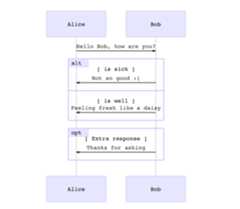
Flowcharts
For more details seethese instructions.
```mermaidgraph LRA[Hard edge] -->B(Round edge) B --> C{Decision} C -->|One| D[Result one] C -->|Two| E[Result two]```
Gantt Charts
For more details seethese instructions.
```mermaid%% Example with selection of syntaxes gantt dateFormat YYYY-MM-DD title Adding GANTT diagram functionality to mermaid section A section Completed task :done, des1, 2014-01-06,2014-01-08 Active task :active, des2, 2014-01-09, 3d Future task : des3, after des2, 5d Future task2 : des4, after des3, 5d section Critical tasks Completed task in the critical line :crit, done, 2014-01-06,24h Implement parser and jison :crit, done, after des1, 2d Create tests for parser :crit, active, 3d Future task in critical line :crit, 5d Create tests for renderer :2d Add to mermaid :1d section Documentation Describe gantt syntax :active, a1, after des1, 3d Add gantt diagram to demo page :after a1 , 20h Add another diagram to demo page :doc1, after a1 , 48h section Last section Describe gantt syntax :after doc1, 3d Add gantt diagram to demo page : 20h Add another diagram to demo page : 48h```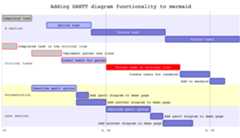
Class Diagrams
For more details seethese instructions.
```mermaidclassDiagram Animal <|-- Duck Animal <|-- Fish Animal <|-- Zebra Animal : +int age Animal : +String gender Animal: +isMammal() Animal: +mate() class Duck{ +String beakColor +swim() +quack() } class Fish{ -int sizeInFeet -canEat() } class Zebra{ +bool is_wild +run() }```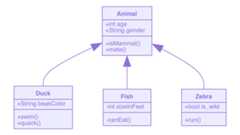
State Diagrams
For more details seethese instructions.
```mermaidstateDiagram [*] --> Still Still --> [*] Still --> Moving Moving --> Still Moving --> Crash Crash --> [*]```
Pie Charts
```mermaidpie title Pie Chart "Dogs" : 386 "Cats" : 85 "Rats" : 150 ```
Requirement Diagram
A Requirement diagram provides a visualization for requirements and their connections, to each other and other documented elements. The modeling specs follow those defined by SysML v1.6.
You can find detailshere.
```mermaidrequirementDiagram requirement test_req { id: 1 text: the test text. risk: high verifymethod: test } element test_entity { type: simulation } test_entity - satisfies -> test_req```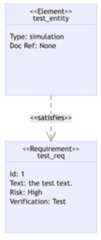
Gitgraph Diagrams / Commit Flow
A Git Graph is a pictorial representation of git commits and git actions(commands) on various branches.
You can find detailshere.
```mermaidgitGraph commit commit branch develop checkout develop commit commit checkout main merge develop commit commit```
C4 Diagrams (plantUML compatible)
Mermaid’s c4 diagram syntax is compatible with plantUML.
You can find detailshere.
Mindmap
A mind map is a diagram used to visually organize information into a hierarchy, showing relationships among pieces of the whole. It is often created around a single concept, drawn as an image in the center of a blank page, to which associated representations of ideas such as images, words and parts of words are added. Major ideas are connected directly to the central concept, and other ideas branch out from those major ideas.
You can find detailshere.
```mermaidmindmap root((mindmap)) Origins Long history ::icon(fa fa-book) Popularisation British popular psychology author Tony Buzan Research On effectiveness<br/>and features On Automatic creation Uses Creative techniques Strategic planning Argument mapping Tools Pen and paper Mermaid```
Timeline
Seehttps://mermaid.js.org/syntax/timeline.html for detail.

Quadrant Chart
Seehttps://mermaid.js.org/syntax/quadrantChart.html for details.
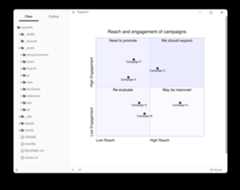
Sankey diagrams
Seehttps://mermaid.js.org/syntax/sankey.html for details.

ZenUML
Seehttps://mermaid.js.org/syntax/zenuml.html for details.

Please notice that zenuml is not first class diagram in mermaid, it may lack some features, like dark themes, etc.
XY Chart
You can find more details here → https://mermaid.js.org/syntax/xyChart.html.
You can now draw charts like this:

Global Mermaid Options
Overview
You can change Mermaid options by addingCustom CSS, supported options include:
:root{--mermaid-theme:default;/*or base, dark, forest, neutral, night */--mermaid-font-family:"trebuchet ms",verdana,arial,sans-serif;--mermaid-sequence-numbers:off;/* or "on", see https://mermaid-js.github.io/mermaid/#/sequenceDiagram?id=sequencenumbers*/--mermaid-flowchart-curve:linear/* or "basis", see https://github.com/typora/typora-issues/issues/1632*/;--mermaid--gantt-left-padding:75;/* see https://github.com/typora/typora-issues/issues/1665*/}Please note that if you export a document with themes other than the currently used one, some mermaid options will not be applied to exported HTML / PDF / Images. For example, if you currently use the Github theme, then export to PDF using the theme YYY and YYY.css defines--mermaid-sequence-numbers: on, then the--mermaid-sequence-numbers: on would not be applied to the exported PDF.
Diagram Alignment
You can add the custom CSS below by followingAdd Custom CSS to left align your diagram.
.md-diagram-panel-preview{text-align:left;}Mermaid Theme
The--mermaid-theme css variable can quickly define a mermaid theme that fits your theme, the value can bebase,default,dark,forest,neutral ornight (the one used in night theme), for example:
| CSS | Mermaid Demo |
|---|---|
:root {--mermaid-theme:dark;} |  |
:root {--mermaid-theme:neutral;} |  |
:root {--mermaid-theme:forest;} |  |
Auto Numbering
Adding--mermaid-sequence-numbers: on; in theCustom CSS will enable auto numbering for sequences in mermaid:
| –mermaid-sequence-numbers:off | –mermaid-sequence-numbers:on |
|---|---|
 |  |
Flowchart Curve
Add--mermaid-flowchart-curve: basis to get other type of curves.
| –mermaid-flowchart-curve: linear; | –mermaid-flowchart-curve: basis | –mermaid-flowchart-curve: natural; | –mermaid-flowchart-curve: step; |
|---|---|---|---|
 |  |  |  |
Gantt Padding
| –mermaid–gantt-left-padding:75 | –mermaid–gantt-left-padding:200 |
|---|---|
 |  |
Inline Mermaid Config
You can add%%{init: [options]}%% to the first line of your mermaid diagram to configure mermaid details as shown below:

You can find full documentation athttps://mermaid-js.github.io/mermaid/#/./directives.
Save-as / Copy on Diagrams
You can right click on a diagram to save it as a SVG, PNG or JPG file on your local disk.
Also, you can right click on a diagram to copy it to your clipboard.